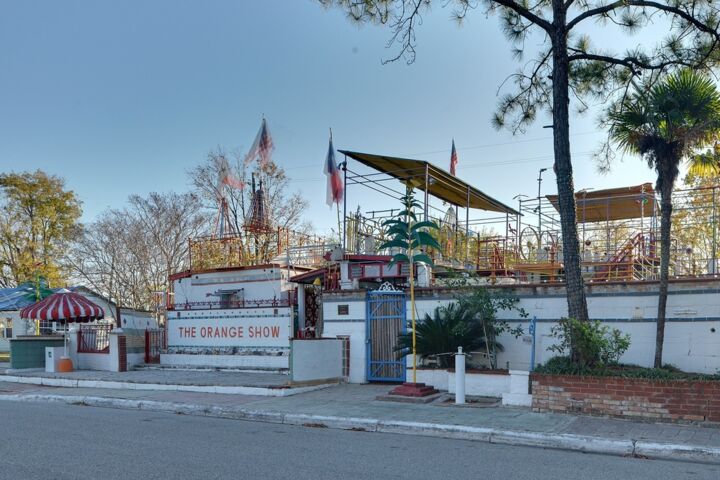 The Orange Show Houston Concert Venue © Ed Uthman
The Orange Show Houston Concert Venue © Ed Uthman
Today, the Orange Show Center for Visionary Art revealed plans for a major expansion. The innovative art space and organization bought a 5.7-acre (2,3 ha) property with a 31,000-square-foot (2879 m2) mid-century building four years ago. The Orange Show's campus will encompass an eight-acre (3,2 ha) area when it's finished, promoting innovation and creation. The OSCVA will be able to display some of its most beloved vehicles from the Art Car procession, which were previously only visible during the yearly parade, thanks to the new site, which was built by Rogers Partners. An 800-foot (244m) ramp that winds its way across the campus, past art cars and an open workshop, is one of the highlights.
"There will be a section of it that focuses on art cars and support for the artist community," says OSCVA executive director Tommy Ralph Pace. "However, I believe that even people who believe they have no understanding of art will be able to overcome this barrier by coming here. It's a spot where you can get lost for hours." Pace says it's "a little early" to confirm the new space's debut date. He does, however, describe 2026 as a "hard objective." "We celebrated our 40th anniversary in style, and there was so much enthusiasm that we couldn't pass up the chance to tell everyone about it."
The OSCVA extension reflects the idea of a single man who believed in the power of art. During the Great Depression, Georgia native Jefferson Davis McKissack drove an orange truck in his home state. Before relocating to Houston in the 1940s, he studied welding and cosmetology and worked as a postal carrier. Beginning in the 1950s, McKissack spent decades collecting construction debris, which he transformed into a 3,000 square foot immersive and sprawling monument to the fruit he adored. In May 1979, McKissack's magnificent totem was completed, and he died eight months later. Preservationists, on the other hand, considered it as an important piece of Houston history that deserved to be preserved. The Orange Show Monument was the seed that developed into the Orange Show Foundation and then the Orange Show Center for Visionary Art, which for more than 40 years provided space and inspiration for artists with, well, a vision.
Though OSCVA is best known for its brightly colored landmark, the organization's work has expanded throughout the city, particularly through the annual Art Car Parade. Other Orange Show locations include John Milkovisch's Beer Can House, which was finished in 1968 after decades-long labor of love, and Smither Park. The park, which is near the OSCVA and the Orange Show Monument, comprises a mosaic park with work by hundreds of local and regional artists. The OSVCA extension also moves the school closer to Fonde Park, another green space. "Our mission will remain the same in the new place," Pace says. "To honor everyone's inner artist. We believe the new campus will allow us to broaden that perspective."


 Selena Mattei
Selena Mattei